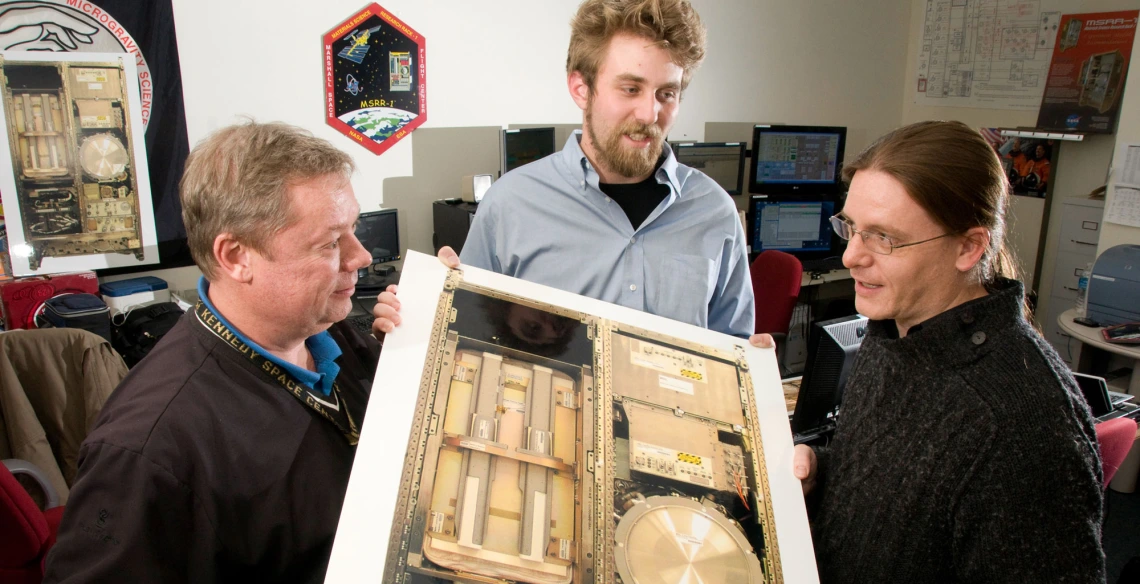UA Engineers Are First US Researchers to Use New NASA Test Bed Aboard Space Station
UA materials science engineers study behavior of molten metals in zero gravity.

Research team members examine a picture of the Materials Science Research Rack, or MSSR. Left to right are John Kramer, MSRR Operations; Matthew Goodman, UA graduate student; and UA professor Robert Erdmann. (Photo: Emmett Given, NASA Marshall Space Flight Center)
When astronauts aboard the Space Shuttle Endeavor docked with the International Space Station precisely on time at 12:06 a.m. EST on Feb. 10, more than 200 miles above the Atlantic west of Portugal, part of their mission was to collect a sample from an experiment conducted by UA College of Engineering researchers.
The small ingot of aluminum-silicon alloy was the first material sample supporting U.S. research to be processed in NASA’s Materials Science Research Rack on the orbiting space station. The rack is fixed to the outside of the station and suspended in open space.
Professors David Poirier and Robert Erdmann of the UA’s Department of Materials Science and Engineering, and professor Surendra Tewari of Cleveland State University, are researching how molten metals solidify in zero gravity and will study the sample.
Down to Earth
Once the material sample is returned to Earth, it will be delivered to NASA’s Marshall Space Flight Center in Huntsville, Ala., for initial examination. The sample then will be taken to Cleveland State University in Cleveland, Ohio, for additional testing. This mission, STS-130, is scheduled to end Feb. 20 when Endeavor returns to Earth.
Poirier and his team are studying a process known as directional solidification. “The model alloy under study by the U.S. investigators is an aluminum-silicon alloy, closely related to alloys used to produce castings,” said Poirier. “The main focus is to study the role of zero gravity on the solidified microstructures that result from directional solidification, and to compare the microstructures with samples made under similar conditions on Earth.”
NASA researcher Frank Szofran added that because there is no buoyancy in space, materials can be developed that have a stronger or more regular structure. “Understanding this structure can help to produce stronger materials on the Earth,” Szofran said.
“In addition to learning about the underlying science of alloy solidification, the space experiments are particularly relevant to the manufacture of alloys used in the high-temperature gas turbines that power aircraft and produce electric power,” Poirier said. The knowledge gained from this research could help the casting industry improve processing and eliminate defects.
International Research
The European Space Agency developed the space station’s onboard Materials Science Laboratory, which contains NASA’s Materials Science Research Rack. The rack includes a furnace that was used to process the metal ingot. U.S. investigators have samples processed in the facility and collaborate with European science teams, which are currently examining the first two samples brought home from the space station.
The Materials Science Research Rack was added to the space station at the end of 2009 and includes a furnace in which samples can be processed at temperatures of up to 2,500 degrees Fahrenheit. Members of the space station crew insert samples in the furnace one at a time, and the experiment is run from Earth by automated command.
The research rack is about the size of a large refrigerator, measuring 6 feet high, 3.5 feet wide and 40 inches deep. It weighs about 1 ton. Development of the research rack was a cooperative effort between the Marshall Center and the European Space Agency.

